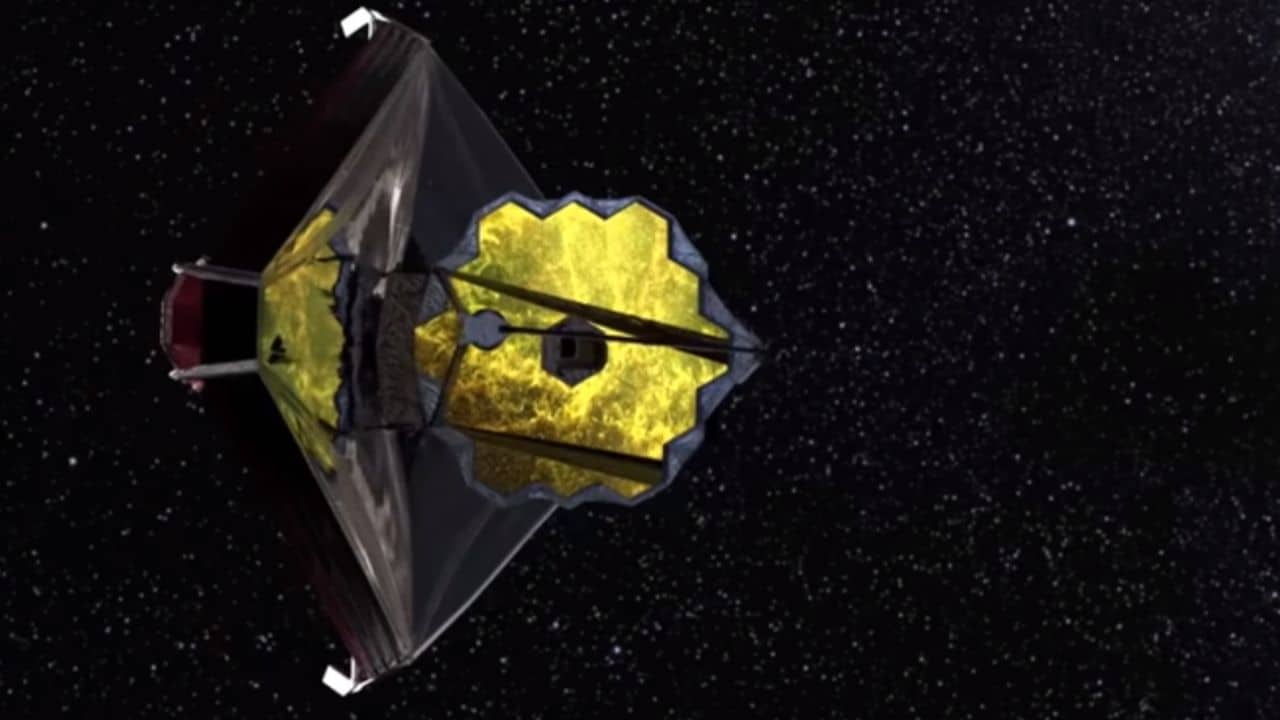It took over a decade to meticulously design and construct Europe’s quartet of identical Cluster satellites for their eventual launch. Astonishingly, these satellites met their fate in just 39 seconds, disappearing in a massive burst of flames.
As the Ariane 5 rocket deviated from its intended course and erupted into a fiery explosion, the remnants of the satellites fell over the South American jungle. The dignitaries who had been indulging in champagne on the open-air observation deck moments earlier were swiftly escorted indoors to avoid the falling debris, preventing potential injuries.
The calamity marked one of the European Space Agency‘s (ESA) most prominent and dramatic setbacks. However, the response was swift, with efforts to initiate a replacement mission, known as Cluster II, getting underway within a matter of months.

Cluster II was devised to fly in a coordinated formation, delving into the intricate interplay between charged particles emitted by the Sun – the solar wind – and the Earth’s protective magnetic shield known as the magnetosphere. The four satellites, affectionately dubbed Rumba, Salsa, Samba, and Tango, have now commemorated an impressive 23 years of orbital existence.
Astoundingly, Cluster II has far outperformed its initial expectations, designed to last only three years. Bruno Sousa, the mission operations manager for Cluster at the European Space Operations Centre (Esoc) in Germany’s Darmstadt, acknowledges the mission’s unexpected longevity. He quips that there’s a group of fervent scientists associated with the mission, some eagerly awaiting its conclusion so they can finally relish their retirement.
Cluster is merely one of the many missions that persist today thanks to the sheer expertise and resourcefulness of the engineering and scientific teams steering them. These dedicated teams navigate through challenges, troubleshooting glitches, overcoming malfunctions, and even averting near-catastrophic failures. A recent example underlining the intricacies of maintaining spacecraft well beyond their initial projected lifespan is the momentary loss of contact with Voyager 2.
Launched almost 46 years ago in 1977, the paired Voyager probes are still actively transmitting data from regions beyond our Solar System.
I reached out to NASA, and they assured me that the control of these spacecraft remains based in the same beige cubicle within an annex of the Jet Propulsion Laboratory (JPL) that I had the chance to visit back in 2017. The cubicle is adorned with a handmade cardboard sign that reads: “Mission critical hardware – PLEASE DO NOT TOUCH.” (For a more comprehensive account of the mission, you can find the full story here, and you can also listen to a radio program I produced about it here.)
This setup might ring familiar to the controllers of the Cluster mission. They’ve grappled with a challenge stemming from 20th-century ground control software built upon an outdated operating system.
“We’ve engineered a rather complex arrangement where contemporary Linux servers run within a virtual environment, featuring an emulator of the antiquated operating system,” explains Sousa. He further elaborates, “The individual responsible for operating the software is a member of the original team; he’ll eventually retire once the mission concludes.”
The matter of power supply has also posed its own challenges. The Cluster satellites are equipped with solar panels to generate electricity. However, twice a year, these satellites venture into Earth’s shadow, requiring batteries to sustain their operations.
Bruno Sousa elaborates on this aspect, noting, “The batteries were initially designed with a five-year lifespan, and by the sixth year, we began to notice a decline in their capacity.” Eventually, issues escalated as cracks developed, leading to leaks that rendered the batteries completely nonfunctional.
To overcome this challenge, a creative solution was devised. As the satellites approach the period of eclipse, they are deliberately powered down. Subsequently, automated signals are transmitted to initiate a reboot, essentially performing a “factory reset” for the Cluster satellites. Interestingly, when it comes to tending to the ongoing well-being of spacecraft, the original manufacturers often play a role in addressing such issues.
Consider Esa’s remarkable XMM-Newton space telescope, measuring an impressive 10 meters (33 feet) in length. Crafted by Airbus, this telescope was meticulously engineered to delve into the x-ray emissions originating from galaxies far away. Over a span of 24 years, this colossal telescope has cast its gaze upon black holes, witnessed the celestial cycles of star birth and demise, and significantly expanded our comprehension of the concealed cosmos. However, around a decade into its mission, signs of wear and tear began to emerge.
Similar to numerous satellites, XMM-Newton relies on thrusters for maneuvering and employs reaction wheels to maintain its stability. These reaction wheels, driven by the energy harnessed by solar arrays, spin swiftly to generate a force that counteracts the telescope’s rotation, thereby preserving its orientation. Originally designed to operate with three such wheels, with a fourth positioned as a backup, these mechanically active components inevitably experienced the wear associated with extended usage, akin to a hard drive showing signs of strain.
Rather than waiting until the reaction wheels faced total failure, the ingenious minds behind the mission had a novel idea. They decided to activate the previously dormant fourth wheel, while simultaneously operating all wheels at a reduced speed.
Patrick Chapman, an accomplished engineer at Airbus based in the UK, sheds light on this innovative solution. Having been involved with XMM-Newton since 1995, he highlights, “We meticulously crafted the intricate algorithms and software, which were then uploaded to the spacecraft back in 2013.” Astonishingly, this ingenious maneuver proved successful, rendering the telescope’s health intact and even leading to fuel conservation.
The tale of XMM-Newton serves as a testament to the remarkable ingenuity and adaptability of space mission controllers and engineers in the face of challenges posed by aging technology.
The process of devising the solution that rescued the telescope unfolded across several months, but occasionally, time isn’t a luxury that can be afforded.
On the morning of September 22, 2021, at 10:30 AM, the Integral mission control room at Esoc, under the jurisdiction of the European Space Agency (ESA), was abruptly filled with alarms. The cause of concern was a malfunctioning reaction wheel within the 19-year-old gamma-ray observatory. This issue not only forced the satellite into a safe mode but, more critically, set it on a gradual path of uncontrolled spinning.
Richard Southworth, the mission operations manager, recounts the situation, highlighting the urgency of the matter. “The alarms were going off incessantly, and the satellite had a mere three hours of power remaining.” As he continues to explain, “The power depletion stemmed from the fact that the satellite was veering away from the Sun.”
Greta De Marco, a spacecraft operations engineer, supplements Southworth’s account by emphasizing the solar angle’s influence on power supply. She adds that, fortunately, the timing of the incident proved somewhat advantageous. “It happened in the morning when we were all present at work. Coincidentally, I was engaged in a Zoom call with approximately 100 Airbus engineers, allowing me to promptly share the anomaly with them.”
This episode underscores the complexities of managing spacecraft anomalies and the indispensable role of collaboration and swift action in averting potential disasters.
The team faced the imperative task of buying themselves some precious time to strategize how to rectify the satellite’s alignment dilemma, as De Marco clarifies. “Our primary goal was to provide the satellite with a clear sense of its orientation. To achieve this, we made the crucial decision to deactivate the instruments.”
Southworth reflects on the critical juncture, recalling the dire situation. “The batteries were swiftly depleting, and I recognized that even a single additional rotation could spell the end. I must admit, I was feeling rather pessimistic at that point.”
Eventually, despite the intermittent communication disruptions arising from the erratic spinning, the team triumphed in recalibrating the speeds of the other functional reaction wheels.
Southworth fondly reminisces about the defining moment when hope rekindled. “I distinctly remember thinking, ‘This has to work; otherwise, our efforts might be in vain.'”
Amidst the countless hours of tenacious effort and the collective dedication of numerous individuals, De Marco highlights the eventual success. “After an extensive and relentless struggle involving numerous individuals, we ultimately succeeded in regaining command over the satellite.”
This account exemplifies the valor of teamwork, perseverance, and strategic decision-making in navigating dire scenarios within the realm of space missions.
The journey of the Integral spacecraft has been marked by steady operation since its rescue, but what if unexpected complications arise while this aging spacecraft is situated around a distant world, a staggering 150 million kilometers (93 million miles) away?
Debuting in 2003, the European Space Agency’s (ESA) Mars Express was initially intended to encircle Mars for a span of two years. Astonishingly, almost two decades later, the mission has not only delved into the intricacies of the Martian atmosphere but has also bestowed us with breathtaking visuals of the Red Planet‘s surface. Furthermore, it has seamlessly acted as a crucial communication link for a series of NASA rovers.
Similar to their counterparts, the mission controllers of Mars Express have also grappled with the challenges posed by aging computer systems. Following an episode involving the spacecraft’s onboard computer glitch, the engineering team devised an innovative method of uploading commands into the vessel’s modest 2MB RAM memory.
Interestingly, they stumbled upon another conundrum related to the spacecraft’s original software for a segment of the onboard navigation system. This software was running on a Windows 98 PC, yet nobody could recall the password to access it. Ultimately, a rather unconventional solution emerged – resorting to bolt cutters to extract the hard drives. Despite these hurdles, the mission soldiered on.
However, the most significant test arrived five years ago, reiterating the formidable nature of mechanical challenges that could prematurely conclude a mission.
Mars Express comes equipped with six gyroscopes responsible for measuring rotation. Coupled with two cameras called star trackers, these components collectively enable the spacecraft to precisely ascertain its orientation in the vast expanse of space. Yet, as 2017 rolled around, the unmistakable signs of gyroscopic deterioration emerged.
Simon Wood, a spacecraft operations engineer, recalls the turning point. “A significant meeting convened to assess the spacecraft’s condition, and the consensus was that it had merely two years of operational life remaining. Exiting that meeting was undeniably disheartening.”
Thankfully, Mars Express adhered to a standardized design that was also adopted for other missions, most notably the cometary explorer, Rosetta. Although Mars Express was not initially intended to function minus its gyros, an innovative prospect arose. Could they potentially repurpose the software designed over two decades ago for Rosetta, allowing the gyros to be deactivated? This unconventional proposition prompted skepticism from colleagues, considering the unprecedented nature of tinkering with onboard software source code. Nonetheless, they persevered.
In 2018, the team embarked on the mission to upload the altered software and initiate a spacecraft reboot. The endeavor was not devoid of risk, particularly considering that the spacecraft hadn’t undergone a cold restart in 12 years. Yet, as Wood recalls, the outcome surpassed their most ambitious aspirations. “The achievement exceeded our wildest expectations, and we now find ourselves blessed with a mission extension stretching until 2028.”
This narrative beautifully illustrates the formidable spirit of innovation and determination that characterizes space missions. The daring pursuit of uncharted solutions often leads to remarkable outcomes that defy conventional limitations.
There’s a prevalent theme of building upon established knowledge in various space missions, as Joseph Hunt emphasizes. This knowledge base serves as a foundation for new endeavors.
However, there’s another remarkable mission that has exceeded even this longevity record. NASA’s Odyssey spacecraft boasts an astounding 95,000 orbits under its belt, securing its position as the oldest operational spacecraft orbiting another celestial body.
Jeffrey Plaut, the mission’s project scientist, expresses his appreciation for this remarkably robust robotic explorer stationed at Mars. He refers to the current phase as a “golden age” in Mars exploration. The mission’s initial projections foresaw its lifespan as a mere handful of years. Nonetheless, its resilience has ushered in unforeseen opportunities, particularly the ability to engage in long-term monitoring of Mars’ weather and climate. Plaut characterizes this capability as truly remarkable.
Plaut’s affiliation with Odyssey dates back to its arrival in Mars’ orbit in 2001. The ongoing operations team, stationed at NASA’s Jet Propulsion Laboratory (JPL) in Pasadena, has undertaken the mission’s stewardship for the past 18 months. This baton was passed on from their predecessors, who had served for decades, thus embodying a seamless continuity of expertise and wisdom.
This narrative is a testament to the enduring impact of space exploration, where missions can far surpass their expected lifespans, leading to unprecedented scientific achievements and fostering an environment of knowledge transfer across generations of scientists and engineers.
Jared Call, the mission manager, bears the responsibility of prolonging the spacecraft’s operational life to its utmost extent. In an ideal scenario, this extension would surpass that of their European Space Agency (ESA) counterpart and collaborator, Mars Express. Good-humoredly, Call remarks, “While I’m not aware of an official contest with Mars Express, if there’s one brewing, I certainly hope we emerge victorious.”
Nonetheless, there’s an inevitable reality that both Mars orbiters will eventually deplete their fuel reserves. Call explains the intricate process of estimating propellant levels, comparing it to a blend of art, mathematics, engineering, and physics. He humorously remarks, “The spacecraft lacks a fuel gauge, so the estimation process is a creative blend, comprising three parts art, two parts math, and one part engineering and physics.”
In the grand scheme of things, regardless of the artistic ingenuity employed by mission controllers, all space missions have a finite lifespan. However, there exists one mission that might transcend this norm. Embarking on their voyage with a golden disc bearing messages from Earth, the twin Voyager spacecraft are poised to persist in their journey for countless millions of years. This endeavor stands as humanity’s legacy to the Universe, a testament that endures long after we have departed from this world.





































